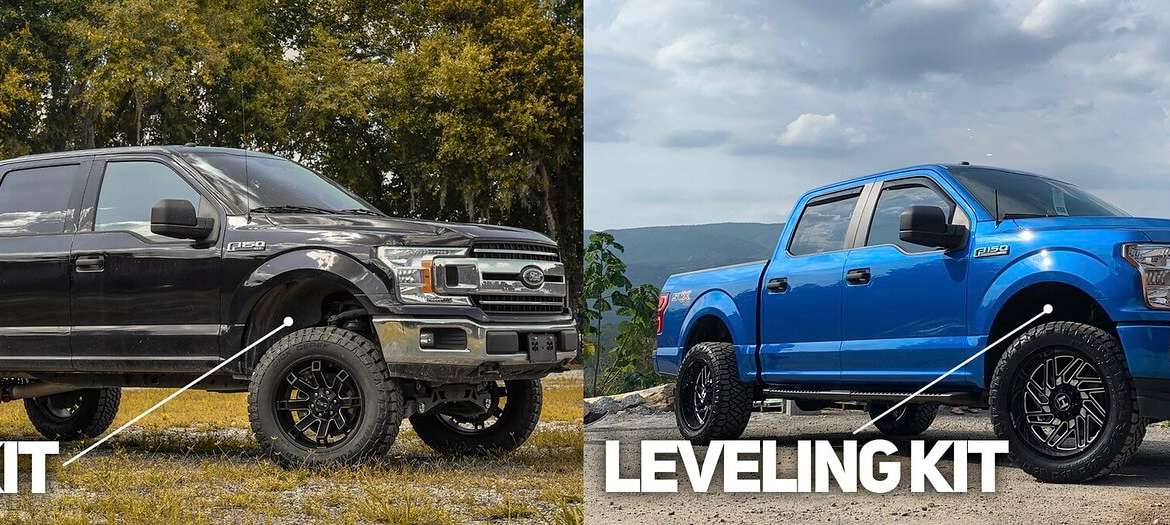Automotive enthusiasts often seek ways to customize their vehicles, and two popular aftermarket modifications for trucks and SUVs are lift kits and leveling kits. While both modifications involve altering the suspension system, they serve distinct purposes and cater to different preferences. In this article, we’ll delve into the key differences between lift kits and leveling kits, exploring their purposes, components, impact on ride quality, installation complexity, and cost.
1. Purpose: Lift Kits vs. Leveling Kits
- Lift Kits:
- Purpose: Lift kits are primarily designed to raise the entire vehicle, increasing the distance between the chassis and the ground. This modification is often favored by off-road enthusiasts who require enhanced ground clearance to tackle challenging terrains. Additionally, lift kits contribute to a more imposing and aggressive aesthetic for the vehicle.
- Application: Off-road enthusiasts, those looking for a more rugged appearance, and individuals requiring increased ground clearance for specific activities.
- Leveling Kits:
- Purpose: Leveling kits are focused on achieving a balanced stance by leveling the front and rear of the vehicle. This addresses the common factory “rake,” where the front of many trucks sits lower than the rear. Leveling kits are often chosen to create a more even look or to accommodate larger tires without affecting the rear suspension.
- Application: Truck owners aiming for a more balanced appearance, improved front-end clearance, and those wanting to accommodate larger tires without changing the rear suspension.
2. Component Modifications: Lift Kits vs. Leveling Kits
- Lift Kits:
- Components: Lift kits typically include taller springs, spacers, or replacement suspension parts to achieve the desired lift. Some lift kits may also involve modifications to steering and drivetrain components to maintain proper functionality.
- Impact: The modification can impact the center of gravity, potentially affecting ride quality and handling. It is essential to choose a lift kit that aligns with the intended use of the vehicle, whether it’s for off-road adventures or on-road driving.
- Leveling Kits:
- Components: Leveling kits commonly consist of spacers, torsion keys for the front suspension, and blocks or add-a-leaf kits for the rear. These components help raise the front of the vehicle to match the height of the rear, achieving a more balanced appearance.
- Impact: Leveling kits generally have a minimal impact on ride quality and handling since their primary goal is to level the vehicle rather than significantly alter its overall height.
3. Ride Quality and Handling: Lift Kits vs. Leveling Kits
- Lift Kits:
- Impact on Ride Quality: Depending on the chosen lift kit, there may be a noticeable impact on ride quality and handling. Some lift kits are designed to maintain or improve on-road performance.
- Considerations: Enthusiasts should carefully consider the intended use of the vehicle and select a lift kit that aligns with their preferences for on-road or off-road performance.
- Leveling Kits:
- Impact on Ride Quality: Leveling kits typically have a minimal impact on ride quality and handling, making them a popular choice for individuals seeking a more balanced stance without compromising the driving experience.
- Balanced Appearance: Leveling kits are often chosen to improve the overall appearance of the vehicle without introducing significant changes to its dynamic characteristics.
4. Installation Complexity: Lift Kits vs. Leveling Kits
- Lift Kits:
- Complexity: Installing a lift kit is usually more involved and may require professional installation. The process often includes more extensive modifications to the suspension system, steering, and drivetrain components.
- Professional Assistance: Due to the complexity, many enthusiasts opt for professional installation to ensure proper alignment and functionality.
- Leveling Kits:
- Simplicity: Leveling kits are generally simpler to install compared to lift kits. Many leveling kits are designed for easy installation and may not require specialized tools or professional assistance.
- DIY-Friendly: Some leveling kits are considered DIY-friendly, allowing vehicle owners to perform the installation themselves with basic tools.
5. Cost: Lift Kits vs. Leveling Kits
- Lift Kits:
- Cost: Lift kits tend to be more expensive than leveling kits. The increased cost is attributed to the additional components and complexity involved in the modification.
- Investment: Enthusiasts seeking a significant lift for off-road purposes are often willing to invest in higher-priced lift kits that provide the necessary performance and durability.
- Leveling Kits:
- Cost: Leveling kits are generally more affordable than lift kits, making them an attractive option for individuals looking to enhance the appearance of their vehicle without a substantial increase in cost.
- Budget-Friendly: Leveling kits offer a budget-friendly solution for those who want to achieve a more balanced stance without breaking the bank.
Both lift kits and leveling kits serve unique purposes in the realm of aftermarket vehicle modifications. The decision between the two depends on individual preferences, intended use, and budget considerations. Lift kits are favored by off-road enthusiasts seeking increased ground clearance and a bold appearance, while leveling kits are chosen for achieving a balanced stance and accommodating larger tires without significant alterations to the vehicle’s dynamics. Ultimately, whether lifting or leveling, these modifications allow vehicle owners to personalize their rides and tailor them to their specific needs and style.


